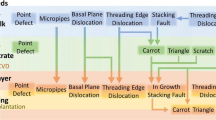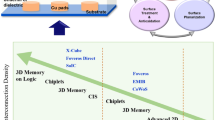Abstract
Electromigration (EM) evaluation near contact corners in interconnection structures composed of dissimilar materials in particular is becoming increasingly important. A theoretical analysis of the atomic density distribution around a right-angled corner in a passivated line composed of dissimilar metals is performed. The 2D structure considered, including the corner, is assumed to consist of dissimilar single-crystal metals with uniform passivation and line widths. While the atomic density distribution in the passivated 1D straight line has been reported previously, the atomic density distribution in a passivated 2D structure that contains a right-angled corner composed of two dissimilar metals has not been studied. This work clarifies the atomic density distribution in the 2D structure under equilibrium conditions for the two fluxes, which are the atomic flux due to the electron wind force and the flux due to the back flow caused by the atomic density gradient in EM, and presents the predicted locations of EM damage in the form of voids and hillocks. In addition, this paper proposes countermeasures to increase the threshold current density for EM, which contributes to enhancement of the reliability of the metal line against EM. The selection of suitable values for several material properties are discussed from the viewpoint of preventing initiation of EM damage by increasing the EM threshold current density. Suitable material combinations to increase the threshold current density are also discussed.





Similar content being viewed by others
References
Abé H, Sasagawa K, Saka M (2006) Electromigration failure of metal lines. Int J Fract 138:219–240. doi:10.1007/s10704-006-0059-6
Aoyama M, Saka M (2014) Evaluation of electromigration resistance of lead-free solders using unpassivated stripe-shaped samples. Microsyst Technol 21:1777–1785. doi:10.1007/s00542-014-2284-7
Black JR (1969) Electromigration failure modes in aluminum metallization for semiconductor devices. Proc IEEE 57:1587–1594
Blech IA (1976) Electromigration in thin aluminum films on titanium nitride. J Appl Phys 47:1203–1208. doi:10.1063/1.322842
Blech IA (1998) Diffusional back flows during electromigration. Acta Mater 46:3717–3723
Blech IA, Herring C (1976) Stress generation by electromigration. Appl Phys Lett 29:131–133. doi:10.1063/1.89024
Blech IA, Tai KL (1977) Measurement of stress gradients generated by electromigration. Appl Phys Lett 30:387–389. doi:10.1063/1.89414
Goldstein RV, Sarychev ME, Shirabaikin DB, Vladimirov AS, Zhitnikov YV (2001) Modeling of electromigration and the void nucleation in thin-film interconnects of integrated circuits. Int J Fract 109:91–121. doi:10.1023/A:1011024712116
Huntington HB (1975) Electromigration in metals. In: Nowick AS, Burton JJ (eds) Diffusion in solids: Recent development. Academic Press, New York, pp 303–352
Huntington HB, Grone AR (1961) Current-induced marker motion in gold wires. J Phys Chem Solids 20:76–87
Ismathullakhan S, Lau H, Chan YC (2013) Enhanced electromigration reliability via Ag nanoparticles modified eutectic Sn–58Bi solder joint. Microsyst Technol 19:1069–1080. doi:10.1007/s00542-012-1701-z
Kimura Y, Zhao X, Saka M (2014) Evaluation of electromigration near a corner composed of dissimilar metals by analyzing atomic flux at the interface. Recent Advances in Structural Integrity Analysis: Proceedings of International Congress. pp 515–518
Kirchheim R (1992) Stress and electromigration in Al-lines of integrated circuits. Acta Metall Mater 40:309–323
Korhonen MA, Børgesen P, Tu KN, Li C-Y (1993) Stress evolution due to electromigration in confined metal lines. J Appl Phys 73:3790–3799. doi:10.1063/1.354073
Lin MH, Lin YL, Chang KP, Su KC, Wang T (2006) Copper interconnect electromigration behavior in various structures and precise bimodal fitting. Jpn J Appl Phys 45:700–709
Lloyd JR, Smith PM (1983) The effect of passivation thickness on the electromigration lifetime of Al/Cu thin film conductors. J Vac Sci Technol A 1:455–458. doi:10.1116/1.571946
Lloyd JR, Smith PM, Prokop GS (1982) The role of metal and passivation defects in electromigration-induced damage in thin film conductors. Thin Solid Films 93:385–395
Nemoto T, Yokobori AT Jr, Murakawa T, Miura H (2010) Numerical analysis of vacancy transport by residual stress in electromigration on LSI interconnects. Jpn J Appl Phys 49:024301. doi:10.1143/JJAP.49.024301
Pierce DG, Brusius PG (1997) Electromigration: A review. Microelectron Reliab 37:1053–1072
Rosenberg R, Edelstein DC, Hu C-K, Rodbell KP (2000) Copper metallization for high performance silicon technology. Annu Rev Mater Sci 30:229–262
Saka M, Zhao X (2012) Analysis of the temperature field near a corner composed of dissimilar metals subjected to a current flow. Int J Heat Mass Transfer 55:6090–6096. doi:10.1016/j.ijheatmasstransfer.2012.06.022
Sasagawa K, Saka M, Abé H (1995) Current density and temperature distributions near the corner of angled metal line. Mech Res Commun 22:473–483
Sasagawa K, Nakamura N, Saka M, Abé H (1998) A new approach to calculate atomic flux divergence by electromigration. J Electron Packag 120:360–366
Sasagawa K, Hasegawa M, Naito K, Saka M, Abé H (2001) Effects of corner position and operating condition on electromigration failure in angled bamboo lines without passivation layer. Thin Solid Films 401:255–266
Sasagawa K, Hasegawa M, Saka M, Abé H (2002a) Governing parameter for electromigration damage in the polycrystalline line covered with a passivation layer. J Appl Phys 91:1882–1890. doi:10.1063/1.1432120
Sasagawa K, Hasegawa M, Saka M, Abé H (2002b) Prediction of electromigration failure in passivated polycrystalline line. J Appl Phys 91:9005–9014. doi:10.1063/1.1475354
Spitzer SM, Schwartz S (1969) The effects of dielectric overcoating on electromigration in aluminum interconnections. IEEE Trans Electron Devices 16:348–350. doi:10.1109/T-ED.1969.16755
Tan CM, Roy A (2007) Electromigration in ULSI interconnects. Mater Sci Eng R 58:1–75. doi:10.1016/j.mser.2007.04.002
Tu KN (2003) Recent advances on electromigration in very-large-scale-integration of interconnects. J Appl Phys 94:5451–5473. doi:10.1063/1.1611263
Tu KN, Yeh CC, Liu CY, Chen C (2000) Effect of current crowding on vacancy diffusion and void formation in electromigration. Appl Phys Lett 76:988–990. doi:10.1063/1.125915
Vairagar AV, Gan Z, Shao W, Mhaisalkar SG, Li H, Tu KN, Chen Z, Zschech E, Engelmann HJ, Zhang S (2006) Improvement of electromigration lifetime of submicrometer dual-damascene Cu interconnects through surface engineering. J Electrochem Soc 153:G840–G845. doi:10.1149/1.2217267
Wever H (1973) Elektro-und thermotransport in metallen. Johann Ambrosius Barth, Leipzig, pp 30–39
Zhao X, Kimura Y, Saka M (2014) Analyzing electromigration near a right-angled corner composed of dissimilar metals by investigating the effect of material combination on atomic flux divergence. Jpn J Appl Phys 53:075504
Acknowledgments
This work was supported by JSPS KAKENHI Grant-in-Aid for Scientific Research (B) No. 26289001.
Author information
Authors and Affiliations
Corresponding author
Appendices
Appendix A
The details of the solution procedure for obtaining Eqs. (8–11) are given herein. By referring Eq. (2), we have the following equations in the radial direction:
and
By substituting Eqs. (4) and (6) into Eqs. (12) and (13), respectively, and integrating Eqs. (12) and (13) with respect to r, N 1 and N 2 are obtained for each of the materials as expressed in Eqs. (8–11).
Similarly, if we consider the circumferential direction, we have the following equations:
and
By substituting Eqs. (5) and (7) into Eqs. (14) and (15), respectively, and integrating Eqs. (14) and (15) with respect to θ, N 1 and N 2 are obtained for each of the materials as expressed in Eqs. (8–11), which are same as the case with Eqs. (12) and (13).
Appendix B
In this work, the distributions of N in the two materials are represented as shown in Figs. 4 and 5. The treated structure composed of dissimilar metals is geometrically asymmetric about the interface, with θ 1 = π/2 and θ 2 = 3π/2, as shown in Fig. 3. If the structure that is geometrically symmetric about the interface with θ 1 = 3π/4 and θ 2 = 3π/2, as shown in Fig. 6, is considered, the singularity parameter is geometrically determined to be ξ = 2/3 without dependence on ρ 1/ρ 2 (Saka and Zhao 2012). The atomic densities N 1 and N 2 at the interface (θ 1 = 3π/4) in the geometrically symmetric structure are independent of r and are constant.
Rights and permissions
About this article
Cite this article
Saka, M., Kimura, Y. & Zhao, X. Theoretical consideration of electromigration damage around a right-angled corner in a passivated line composed of dissimilar metals. Microsyst Technol 23, 4523–4530 (2017). https://doi.org/10.1007/s00542-016-3178-7
Received:
Accepted:
Published:
Issue Date:
DOI: https://doi.org/10.1007/s00542-016-3178-7





